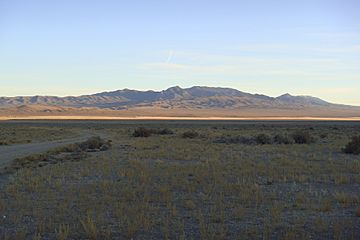Mountain Home Range facts for kids
Quick facts for kids Mountain Home Range |
|
|---|---|

The range at sunset, from the northwest
|
|
| Highest point | |
| Peak | Needle Benchmark |
| Elevation | 9,480 ft (2,890 m) |
| Dimensions | |
| Length | 25 mi (40 km) N/S |
| Width | 23 mi (37 km) E/W |
| Area | 424 sq mi (1,100 km2) |
| Geography | |
| Country | United States |
| State | Utah |
The Mountain Home Range is a cool mountain range in Utah, United States. It stretches from north to south in western Beaver County. This area is part of a larger region called the Basin and Range Province.
The Mountain Home Range is bordered by different valleys. To the west is Hamlin Valley, and to the north is Snake Valley. On the east side, you'll find Pine Valley. To the south, it connects with the Indian Peak Range.
Together, the Mountain Home Range and the Indian Peak Range are often called the Needle Mountains. This is because their peaks look sharp and jagged, like needles!
The tallest point in the range is called the 'Needle benchmark.' It stands at about 9,480 feet (2,890 m) high. Not many people visit this range. It's mostly known for its amazing wildlife and wild horses that roam freely.
Mountain Geology Explained
The rocks that make up the Mountain Home Range tell a long story. The northern part of the range has very old rocks. These are called Paleozoic carbonate rocks. They are part of a huge line of rocks that stretches through other ranges like the Burbank Hills and Confusion Range.
This area also has a massive syncline. A syncline is like a giant U-shaped fold in the layers of rock. It's about 30 by 50 miles wide! The southern part of the range is made of younger rocks. These are called mid-Tertiary ignimbrites. They came from a huge ancient volcano called the Indian Peak Caldera Complex.


